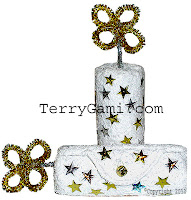 |
| TerryGami, 15 Cloth Toy and Ornament Projects for Crafters, Teachers, and Children |
The book is available at:
TerryGami washcloth crafts is one of my “WIGs” or “wildly improbable goals" Martha Beck talks about in her book “Finding Your Own North Star.” I know there are people like me who have wanted to see a craft organized around using washcloths similar to the little Boo Boo Bunny. I hope TerryGami will live up to their expectations.
Yesterday, I realized something when vetting some of the critters with some 12 and 13 year old girls. They didn’t know that washcloths are made from a fabric called terrycloth. It never occurred to me that they wouldn’t know that because it seems as though terrycloth has been around forever.
As far as terrycloth goes, I will have to do additional research one day to verify this information, or please feel free to chime in on this version of the story. From what I can gather on the web, terrycloth has at least been around since the middle of the 1800s. The material and weaving technique was invented in France. The French used silk to weave this new, looped fabric. Later, Englishmen made the material, first from worsted (a wool yarn), and then later from cotton. The Englishman Samuel Holt brought it to the United States, patented the looped weaving technique, and later sold it to a cotton manufacturer. The loops in the fabric make it very water absorbent. This is why washcloths and towels are made from this material.
As far as terrycloth goes, I will have to do additional research one day to verify this information, or please feel free to chime in on this version of the story. From what I can gather on the web, terrycloth has at least been around since the middle of the 1800s. The material and weaving technique was invented in France. The French used silk to weave this new, looped fabric. Later, Englishmen made the material, first from worsted (a wool yarn), and then later from cotton. The Englishman Samuel Holt brought it to the United States, patented the looped weaving technique, and later sold it to a cotton manufacturer. The loops in the fabric make it very water absorbent. This is why washcloths and towels are made from this material.
One thing I can tell you about learning to sew on terrycloth is that, if you match the thread to the washcloth, you can barely see the stitches. Kids just learning to sew can get great results their first time sewing. Also, with the easier items, they don’t have to worry about cutting out a pattern of any kind; the critters are shaped and rolled from washcloths, and then sewn together.
Some of the new TerryGami items will involve a little more sewing, which will be good practice, but I would suggest to always start with the easier critters first. I would also recommend that the instructor or parent have the children take a minute to read through the entire set of instructions first, asking them to match the words to the illustrations, as they go. If the children are young, read through the instructions with them. This way they get the whole concept of how to put the critter together, so when they start to assemble it, they can just refer to the illustrations for a quick reference.
Many of the TerryGami items can also be glued with fabric glue. If the children cannot manage to sew yet, you may want to go this route. Apply the glue with a cotton swab to avoid a glob of glue spewing out from the spout and ruining the critter. Be sure the critter or ornament is assembled right first before it is glued because there are no second chances with glue. If sewing the item, the stitches can always be ripped out and sewn again.
Another thing to watch when gluing is not to get any of the glue on other parts of the terrycloth because it won’t come off easily, but you can try to wash it off. Another option is to sew some of the critter and glue some of the critter. This way the children learn how to do it both ways. It may even help in a pinch, if you are running out of time finish the project by gluing it. Sewing can take some time, especially if a lot of sewing is involved. Plan a head if this might be the case, when using TerryGami in a party or group situation where there may be a time crunch.
If you don't know what a Boo Boo Bunny is, check out terrygami.com for free instructions.
The Firecracker Party Favor Box Instructions and the Heart Favor Box Instructions are now available on Etsy.
The book is available at:
Happy Crafting with Terrycloth!
~Terry


























